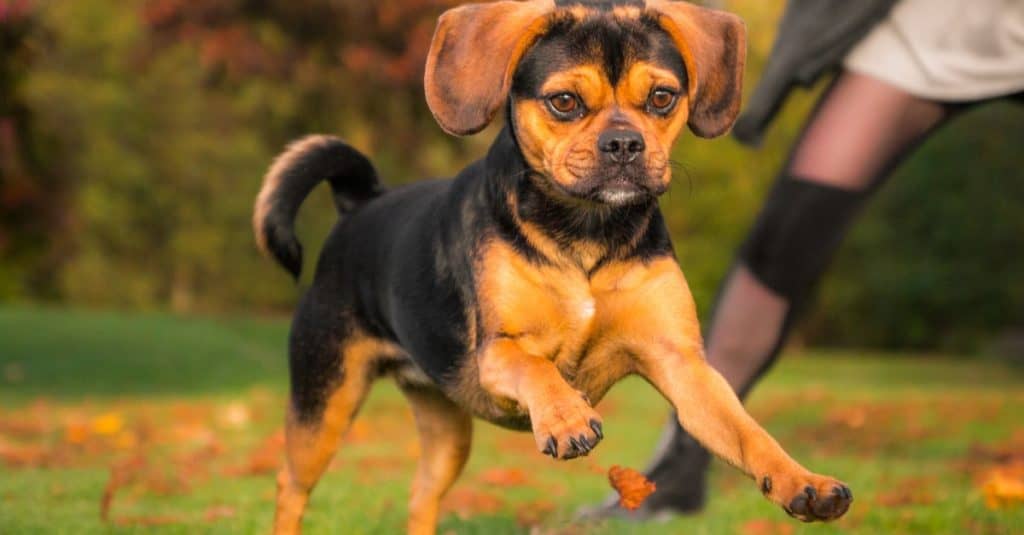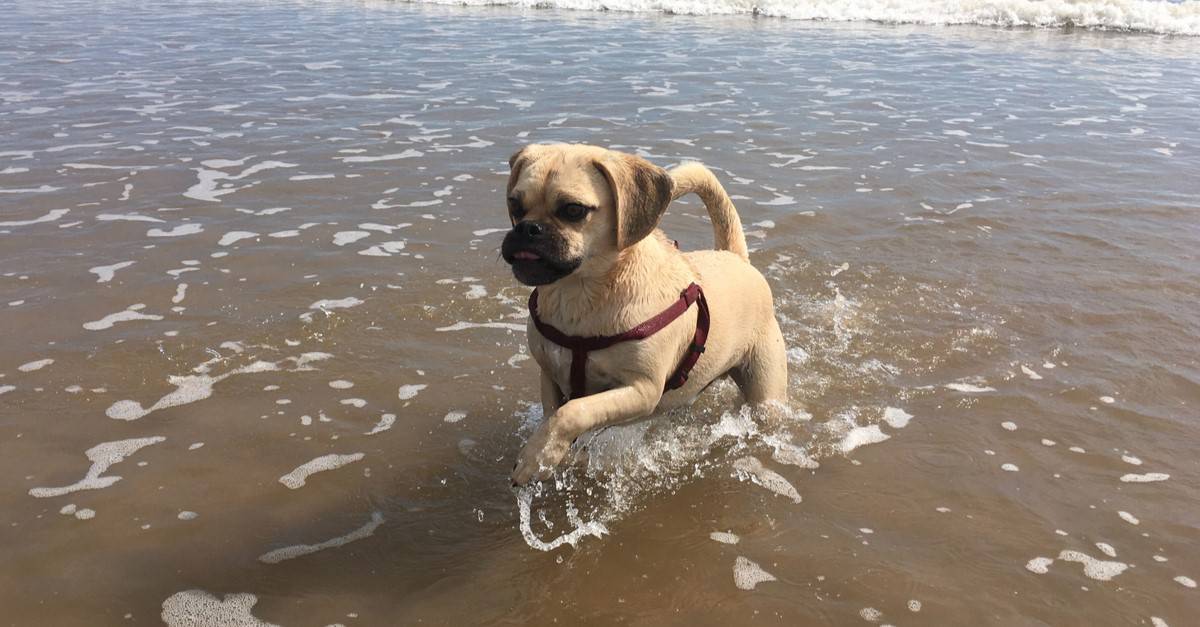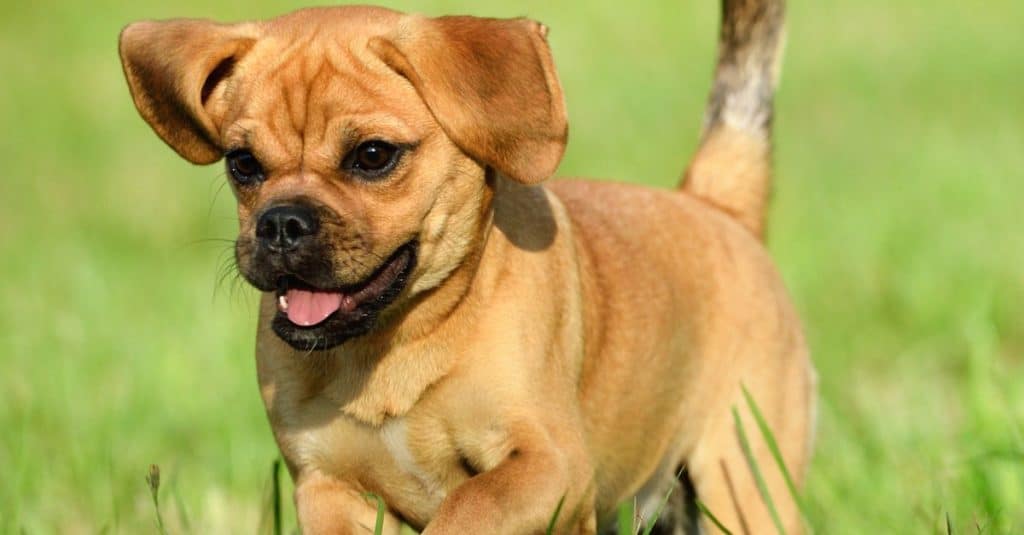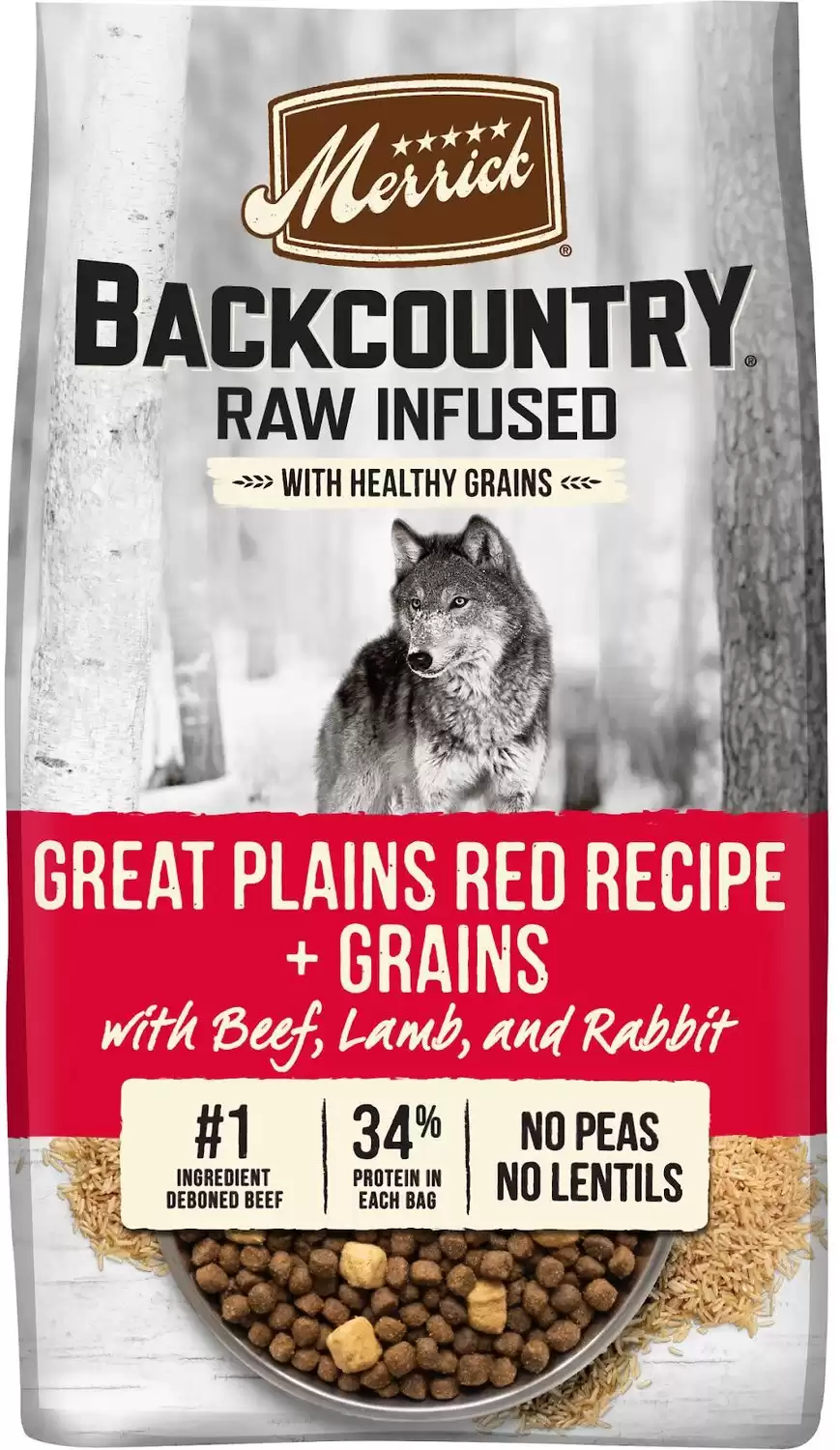Puggle
Canis lupus
These dogs are active and are often patient around children.
Advertisement
Puggle Scientific Classification
- Kingdom
- Animalia
- Phylum
- Chordata
- Class
- Mammalia
- Order
- Carnivora
- Family
- Canidae
- Genus
- Canis
- Scientific Name
- Canis lupus
Read our Complete Guide to Classification of Animals.
Puggle Conservation Status
Puggle Facts
- Fun Fact
- These dogs are active and are often patient around children.
- Temperament
- Active, friendly, energetic, intelligent, and playful
- Diet
- Omnivore
Puggle as a Pet:
- General Health
- Energy Level
- Shedability
- Trainability
- Intelligence
- Tendency to Chew
- Size
- Family and kid friendliness
- Yappiness / Barking
- Moderate
- Separation Anxiety
- Moderate
- Preferred Temperature
- Average climate
- Exercise Needs
- Low
- Friendly With Other Dogs
- High
- Pure bred cost to own
- $800 to $1,500 average price
- Dog group
- Toy
- Male weight
- 18-30 lbs
- Female weight
- 18-30 lbs
This post may contain affiliate links to our partners like Chewy, Amazon, and others. Purchasing through these helps us further the A-Z Animals mission to educate about the world's species.
View all of the Puggle images!
The puggle is a crossbreed between a pug and a beagle. These dogs are social and have a very vibrant personality, complemented by a very beautiful appearance.
The puggle has a wrinkled body that is just like the pug it is bred from. However, their noses are longer than those of pugs. They make great family pets, have a friendly nature, and are also very intelligent.
See all of our expert product reviews.
These dogs are very affectionate and bring a lot of energy to your house. They are also known to be patient with the children of the house. However, it is also always said that they should be supervised around children. You can either buy these dogs from pet shops or can adopt them from rescue shelters. They suffer from various diseases including hypothyroidism, patellar luxation, and arthritis.
Pug vs. Puggle
Pugs are one of the parents for the puggles – the other being a Beagle. While the Puggle has many qualities of the pug, their breeding with the beagle separates them. Both the pug and the puggle have wrinkled bodies, but the Puggles weigh much more at 18 to 30 pounds. Pugs, on the other hand, only weigh around 13 to 20 pounds. Puggles also have longer noses than pugs. Pugs are compact in size and weight and puggles are known to be lengthier and lean.

3 Pros And Cons Of Owning A Puggle
Before you decide to adopt from a rescue shelter or buy one with a breeder, understanding the personality and qualities of that Puggle can make a difference. Here are a few pros and cons of owning a Puggle.
| Pros! | Cons! |
|---|---|
| Active: These dogs are active and energetic and would instantly energize the atmosphere of your house. | Shedding: Just like their parents these dogs are also shed very but which could be a problem for their owners. Supervision around children: These dogs have to be supervised if they are around children especially infants as they can unintentionally end up hurting them. Health issues: These dogs can develop a variety of health issues. You can also develop overweight issues if they are overfilled. |
| Easy to train: They are not very difficult to train and would pick up commands quickly. | Supervision around children: These dogs have to be supervised if they are around children especially infants as they can unintentionally end up hurting them. |
| Intelligent: These dogs are very intelligent which is why they can pick up commands quickly. | Health issues: These dogs can develop a variety of health issues. You can also develop overweight issues if they are overfilled. |
History Of The Breed
First bred in the United States, the puggle is a designer dog that started in the 1980s and has been registered with the American Canine Hybrid Club. The goal of this breed was to create a dog that was a healthy companion dog, one that was not as likely to inherit some of the behavioral and health issues of its parent breeds, the Pug and the Beagle.
The parent breeds of the puggle are the Pug and the Beagle both very ancient breeds. The pug is a breed that began in China and can date back to 400 CE. The were bred as companion dogs for the very wealthy. The beagle is thought to have come from a large white scenthouse called the Talbot hound that was brought into the United Kingdom in the 11th Century by William the Conqueror.
Health and Entertainment for your Puggle
See all of our expert product reviews.
Size And Weight

Puggles are small, usually weighing about 18 to 30 pounds and standing 13 to 15 inches.
©Fluechter Photography/Shutterstock.com
Considering the size of their parents, these hybrid dogs are compact. Puggles are about 13 to 15 inches in size and usually weigh about 18 to 30 pounds when they are fully grown. However, you can also find toy-sized Puggles which are known to be less than 13 inches tall and weigh about 8 to 17 pounds.
| Height (Male) | 13-15 inches tall |
| Height (Female) | 13-15 inches tall |
| Weight (male) | 18-30 lbs., full-grown |
| Weight (female) | 18-30 lbs., full-grown |
Common Health Issues
The hybrid Puggles are crossbreeds, which can ultimately lead to the development of genetic health problems. Issues with the eyes and skin are rather common, but there are a few specific conditions that are a little more common.
Hypothyroidism, which impacts the dog’s thyroid gland, is one of the major concerns of this breed. Some Puggles also are at risk for epilepsy and patellar luxation, so you may want to see a veterinarian if any concerns arise. If your Puggle begins to limp or have difficulty walking, these symptoms could be a sign of hip dysplasia or arthritis.
The main issues that you should look out for with your Puggle include:
- Hypothyroidism
- Patellar luxation
- Epilepsy
- Hip dysplasia
- Eye problems
- Skin problems
- Arthritis
Temperament

A Pug x Beagle mixed breed dog, also known as a “Puggle”, could bark a lot or can be friendly and social.
©Mary Swift/Shutterstock.com
It is not easy to determine how the temperament of these hybrid dogs might turn out to be as they can mimic either of their parents’ personalities. If they turn out to be like beagles, they could bark a lot but have incredible intelligence. If their personality is more like the pug, they’ll likely be friendly and social. They are known to get along well with other pets.
If introduced into a social circle early on in life, these hybrid dogs can turn out to be very well-trained and can handle behavioral issues effectively. This socialization gives them a relatively welcoming temperament. These dogs can sometimes act stubborn while you are in the middle of training them.
How To Take Care Of A Puggle
With any animal that you adopt or rescue, preparing the home for them is of the utmost importance. Here are some ways to take care of the Puggle to make sure that they have a happy and healthy life with their family.
The Best Dog Food For Puggles
To keep your dog healthy, you must give them the best possible food to meet the nutritional requirement of the dog. The type and amount that your dog will need as food will require on his age, weight, size, and metabolism.
Avoid overfeeding your dog as it could lead to various health issues with your pup’s weight. These dogs should be fed high-quality dry food (like kibble). You need to break down their meals into two to three smaller portions which can be given to these dogs throughout the day.
A-Z Animals thinks the best dog food for Puggles is Merrick Backcountry Raw Infused Healthy Grains Dry Dog Food.
Some of the greatest advantages of this beef, chicken, and salmon formula include glucosamine and chondroitin for mobile joints that keep your dog moving for many years. The taurine is important as an eye health aid, and the natural omegas nourish smooth skin and fur.
You can purchase Merrick Backcountry Raw Infused dog food on Chewy or Amazon.
- Freeze-dried raw coated kibble and raw pieces
- Beef, lamb, and rabbit with wholesome grains
- No peas or lentils
Maintenance And Grooming

Puggles don’t need to be bathed often but should be brushed weekly.
©sirtravelalot/Shutterstock.com
Puggles have short and coarse coats, and they should be brushed weekly with a rubber brush to remove the fur that they shed. However, they do not have to be bathed too often, only really requiring it on an “as needed” basis.
The Puggle still has basic grooming needs, including brushing your dog’s teeth regularly (to avoid any dental problems), cleaning the ears (to avoid infection or blockage), and trimming their nails as and when required.
Training

Puggles are not hard to train but a positive attitude is best for them.
©iStock.com/shotbychatty
Due to the intelligence of the parent breeds, the puggle is not very difficult to train. They are relatively people-friendly and are easy to train. They are sensitive to their owner’s behavior, which is why a positive attitude is of the utmost importance while training.
Consistency is the key with them, and negative punishment could harm these dogs. Even though positivity is the key, avoid overloading these dogs with treats because it can lead to weight issues and it won’t teach them to impress their owner at all.
Exercise
Puggles are active and energetic and will instantly make the family’s environment very energetic and happy. They are active and would need at least a 15-minute walk every day. They would also require some playtime in the house.
Puppies

10-week-old Puggle puppies should be introduced to a social circle early in life so they don’t develop behavioral issues.
©anetapics/Shutterstock.com
You can take care of Puggle puppies much like the way would take care of an adult Puggle. The only difference would be that you would need to introduce the puppies to a social circle early on in life so that they develop good habits and do not develop any behavioral issues. You would also need to feed the puppies foods in smaller quantities spread into several meals throughout the day as their tiny stomachs would not be able to take too much food at once.
Puggles And Children
These dogs are active energetic and playful around children. They tend to be patient with the kids of the house and can be good playmates when they grow up with the kids of the family. However, we should always be supervised when they are around children, especially infants. As sweet as the dog is, its playful nature can lead to accidental injuries.
Dogs Similar To The Puggle
If a Puggle isn’t the right pet for your family, that’s okay! Here are a few similar dogs.
- Pugs: The Pug has low maintenance needs and is relatively friendly. They also have a big personality.
- Beagles: These dogs are small in size and are playful. They are also friendly with the kids of the families.
- French Bulldogs: These dogs are quiet and low maintenance. They make great companions and great family pets.
Famous Puggles
Several celebrities own Puggle dogs. These include Uma Thurman, Jake Gyllenhaal, Kelly Osbourne, and Sylvester Stallone. The late James Gandolfini (who played Tony Soprano) also had a particular affinity for the hybrid dog.
Popular Names For The Puggle
Here are some common names for your Puggle dogs:
- Daisy
- Lola
- Bella
- Otis
- Max
Puggle FAQs (Frequently Asked Questions)
What is a puggle?
Puggles are small crossbreed dogs that are a mix of a pug and a beagle. They are about 13 to 15 inches in size and weigh about 18 to 30 pounds.
Are puggles lazy?
This might not apply to all puggle dogs, but these dogs can be extremely lazy. They would usually have no problem lying around on the couch all day.
How much do puggles cost?
The cost or price of these dogs would be anywhere between $800 to $1200. You could expect an additional price or cost of $1000 for its annual maintenance.
What does a puggle look like?
These dogs are compact and have wrinkled bodies. However, they do have longish and lean bodies. They also have longer noses than pugs.
What is the average lifespan of a puggle?
The average lifespan of a puggle is about 10 to 15 years.
Is the puggle good with kids?
Yes, these dogs are patient and playful around children. However, you would need to supervise these dogs around children as they could end up hurting them unintentionally, especially infants.
Thank you for reading! Have some feedback for us? Contact the AZ Animals editorial team.
Sources
- Vetstreet, Available here: http://www.vetstreet.com/dogs/puggle#grooming
- Dog Mal, Available here: https://www.dogmal.com/puggle/
- Rover, Available here: https://www.rover.com/blog/puggle-people/


















